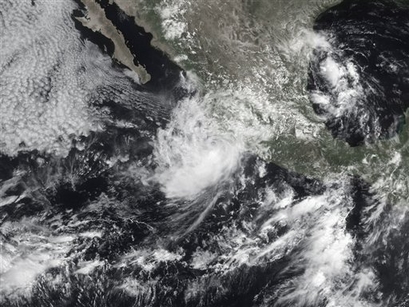
The National Hurricane Center says the storm's maximum winds have decreased to 70 mph from near 75 mph earlier Tuesday.
Andres is forecast to weaken even more in the next day.
The center of the storm as of 11 p.m. EDT was about 110 miles (180 kilometers) west-southwest of Manzanillo.
Andres is moving near 10 mph (17 kph) toward the northwest. It is forecast to track toward the west-northwest and pass very close to or over the southwestern coast of Mexico.
This is a breaking news update. Check back soon for further information. AP's earlier story is below.
PUERTO VALLARTA, Mexico (AP) - Andres strengthened into the Pacific season's first hurricane Tuesday, flooding homes, toppling trees and killing at least one person as it swiped Mexico's southwestern coast with wind and rain.
Andres packed maximum winds near 75 mph (120 kph), just over the threshold of hurricane strength, but was expected to weaken over the next day or two, the U.S. National Hurricane Center said.
The center of the storm as of 8 p.m. EDT (0000 GMT) was about 70 miles (110 kilometers) west of the port city of Manzanillo. Moving near 13 mph (21 kph) toward the northwest, it was forecast to pass very close to or over the southwestern coast later Tuesday.
Mexican authorities posted a hurricane warning for the coastal strip from just south of Manzanillo to near Puerto Vallarta, and heavy rain flooded homes and wind blew down trees in the states of Jalisco, Colima and Guerrero.
In Puerto Vallarta, port authorities said the arrival of the cruise ship Carnival Splendor was rescheduled from Wednesday to July 1.
Authorities opened 18 shelters and were visiting high-risk areas to advise residents to leave, said Alfredo Rivas, director of Puerto Vallarta's Fire Department.
Rivas said people were staying put on Tuesday because it was raining lightly and they didn't feel they were in danger.
"We are telling them they need to take precautions because it went from a tropical storm to a hurricane," Rivas said.
Rain poured down on Manzanillo, where authorities opened 14 shelters amid forecasts that the storm would likely graze the city.
Forecasters said Andres would then churn past tourist towns such as Barra de Navidad that are home to some American and Canadian expatriates.
It was raining lightly in Barra de Navidad on Tuesday afternoon but hotels were already preparing.
"We've been collecting candles, flashlights and other lights that don't use electricity, and we've been collecting bedspreads and sheets in case of an evacuation," said Mari Oregon, who works at Hotel La Alondra.
To the south, rain caused flooding Monday in the resort of Acapulco that forced about 200 people to evacuate their homes. A fisherman drowned when choppy currents overturned his boat in a lagoon in Tecpan de Galeana, between Acapulco and Zihuatanejo, a state police report said.
The sun peeked through cloudy skies in Acapulco on Tuesday, but the government closed all schools.
The U.S. National Hurricane Center said Andres could bring a storm surge of as much as 3 feet (nearly 1 meter) above normal while dumping as much as 8 inches (200 millimeters) of rain in a few spots.
The forecast track showed the storm then weakening as it continues northwest along the coast before veering into the open Pacific and just south of the Los Cabos resorts at the tip of the Baja California peninsula Thursday morning.
Late Sunday, Andres became the first named storm of the eastern Pacific hurricane season, which began May 15 and ends Nov. 30.



Reader Comments
to our Newsletter